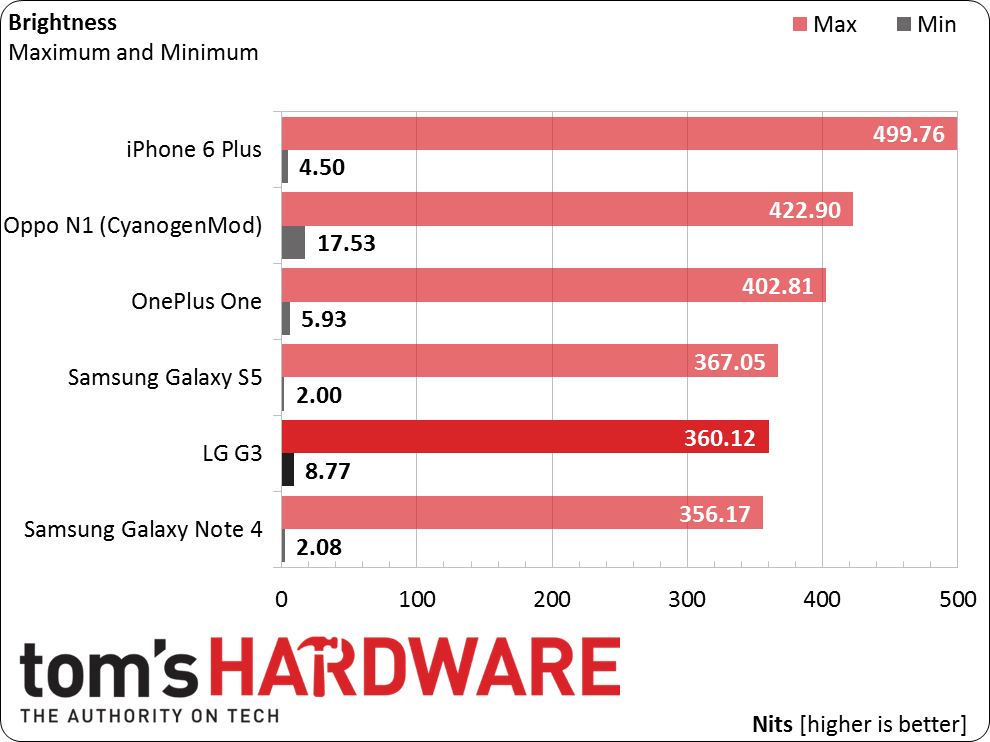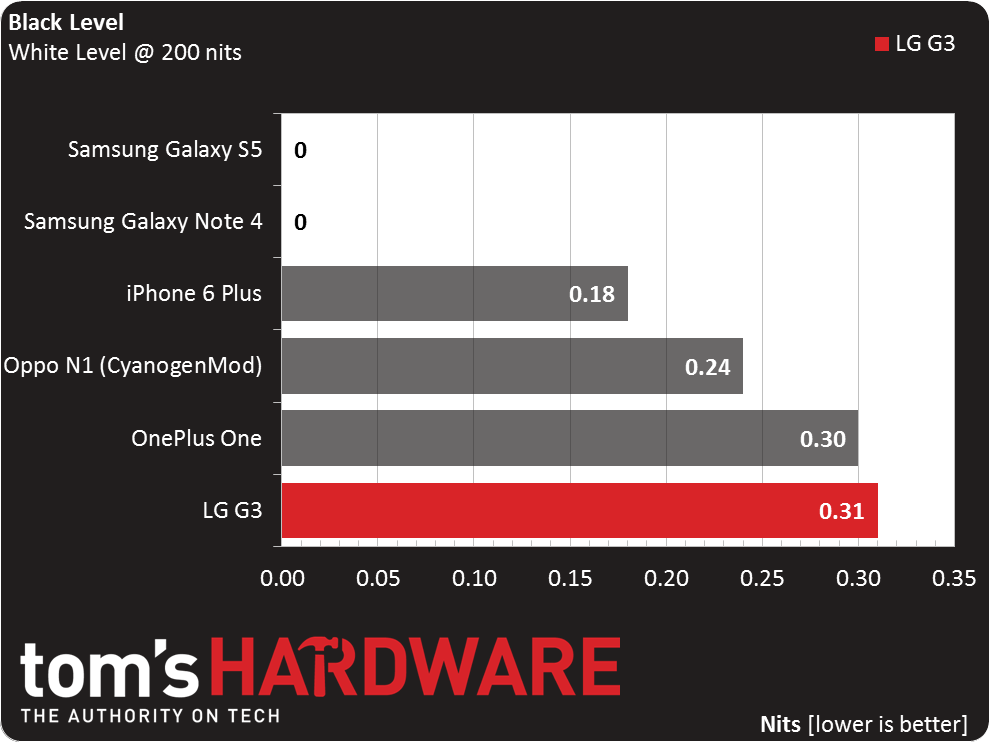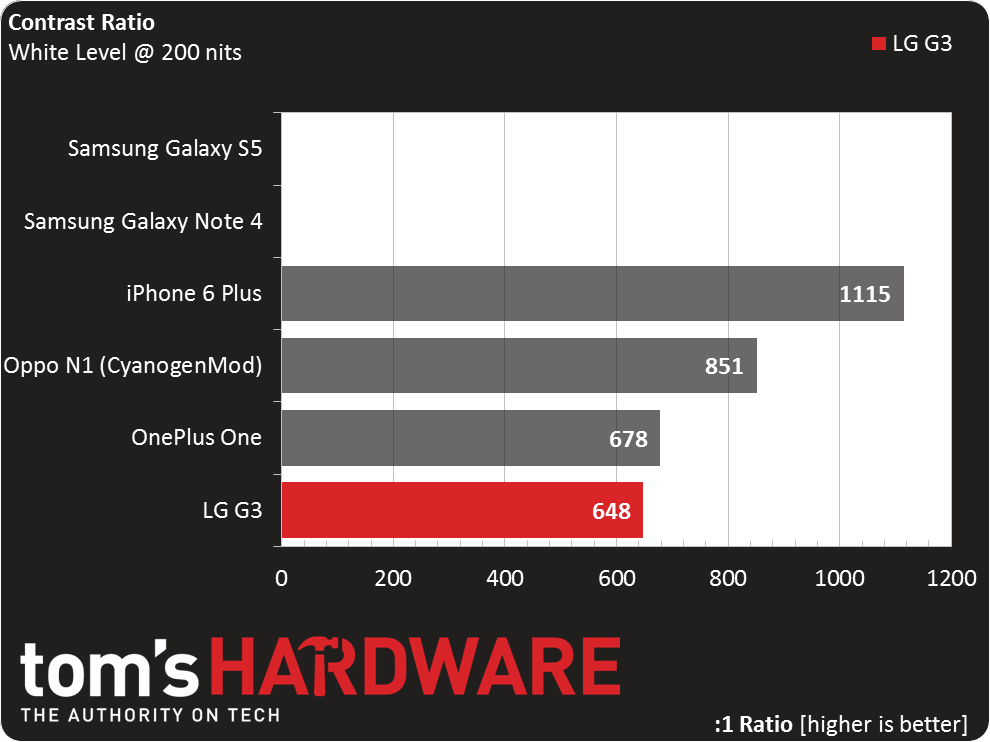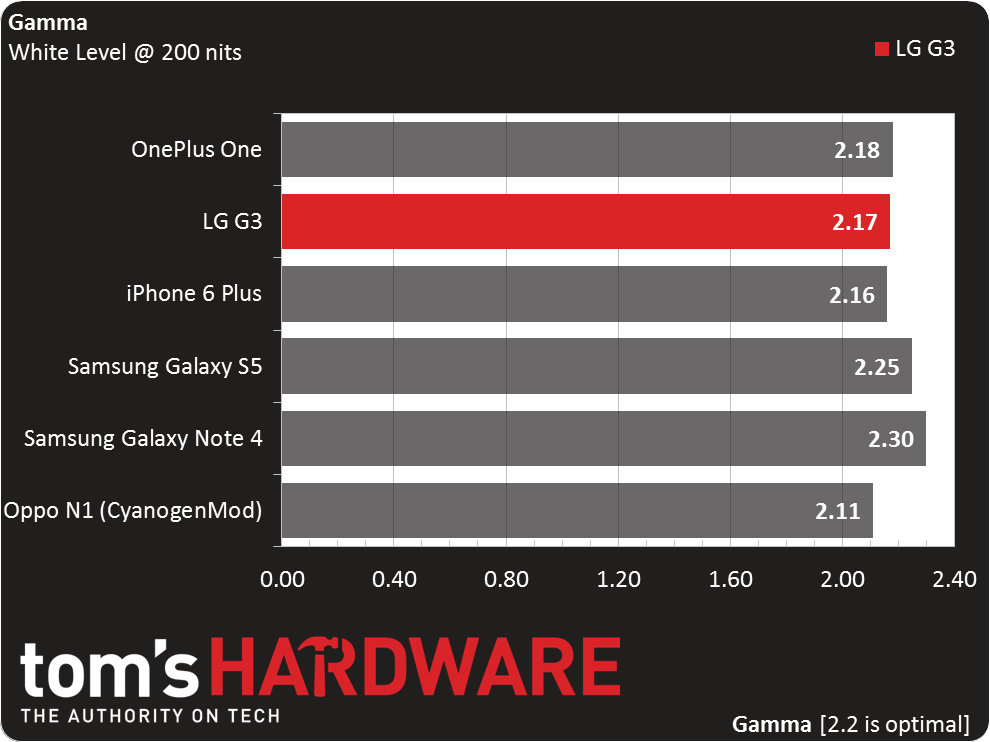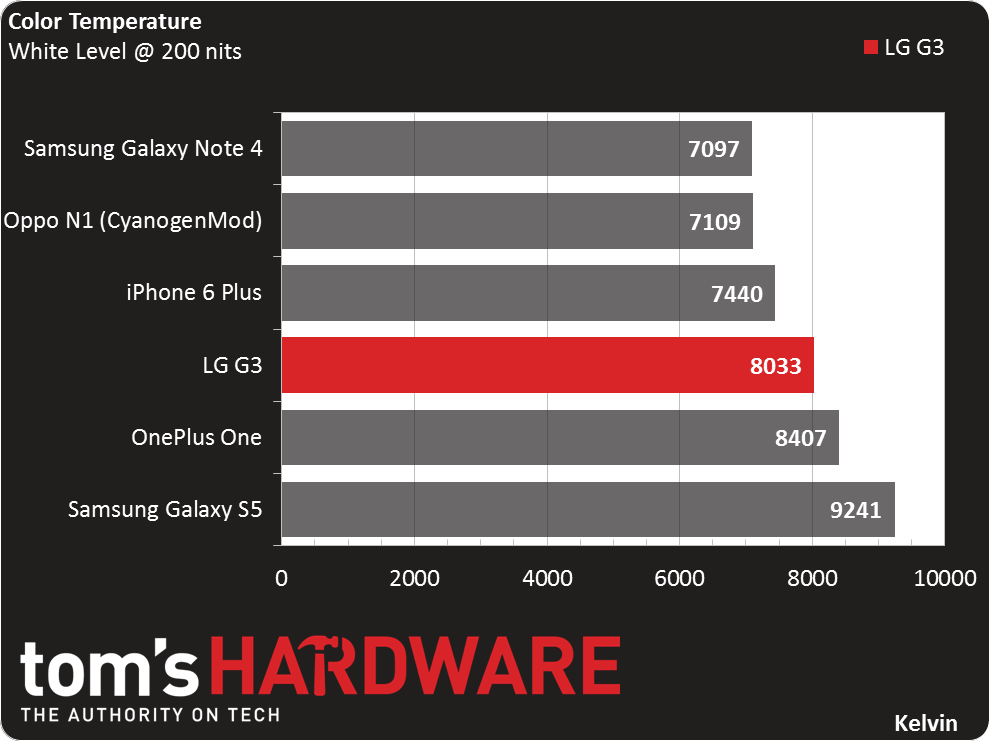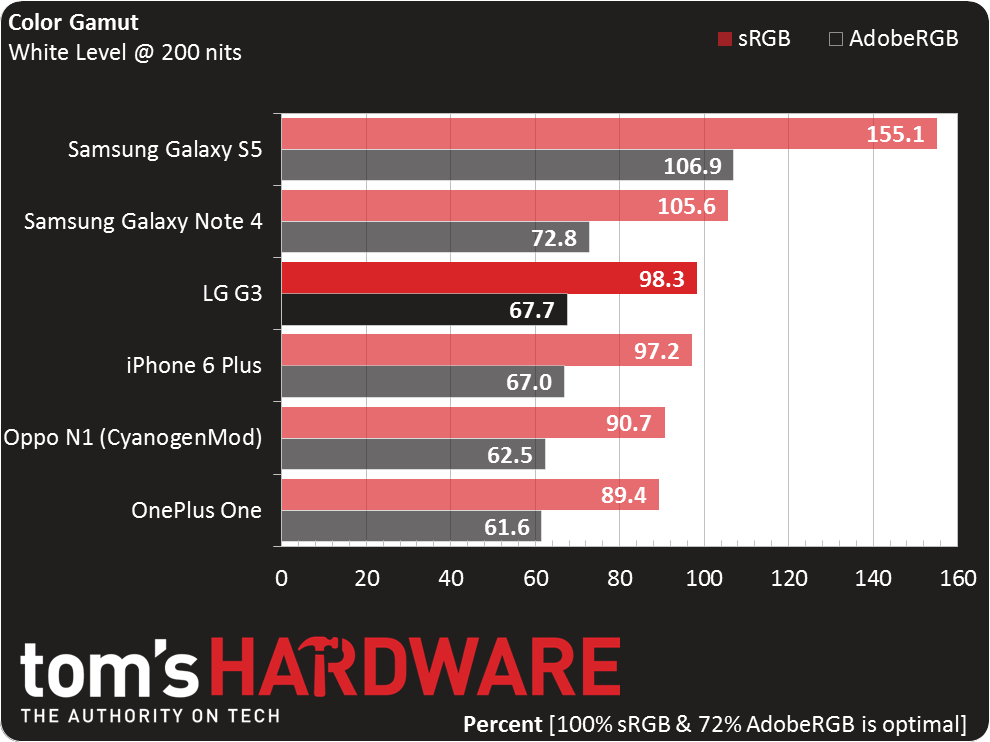LG G3 Smartphone Review: A Plethora Of Pixels And A Laser!
The LG G3 combines cutting-edge hardware, including a 5.5-inch WQHD screen and laser autofocus system, with a lightweight body and slim bezels to create a phone that was ahead of its time. Is it still worth your consideration? Read on for our impressions.
Why you can trust Tom's Hardware
Results: Display Measurements
Brightness
Brightness (also known as white level) measurements are taken by recording the luminance output of each device displaying a full white pattern, with the device's brightness slider set to both minimum and maximum values.
The G3 is about average in maximum brightness, falling just shy of the 400-nit mark. This is likely the result of less active area in the higher-resolution panel. We definitely would like to see a higher peak brightness available for outdoor viewing.
In order to make device comparison possible, the rest of our display measurements, along with our battery testing, are performed with the screen set to a standardized white level of 200 nits.
Calibrating the G3’s display to 200 nits is complicated by a sneaky power-saving feature. After manually setting the screen brightness, the value is lowered approximately 15% after a period of time. The premise of this feature is that the user won’t perceive the difference in brightness, while conserving power. Though this feature may be useful in some scenarios, it definitely doesn’t help outdoor readability when the max brightness drops to 300 nits or less.
Unfortunately, LG doesn’t provide a way to disable this behavior. Therefore, we had to account for this dimming when calibrating our display to 200 nits for testing.
Black Level
Our black level measurement is the luminance output of a full black pattern after the luminance output of full white has been standardized to 200 nits. It's important to note that AMOLED displays will always measure a black level of zero, since their pixels simply turn off to render black.
The G3’s black level can’t compete with the iPhone 6 Plus, but still registers a respectable value, preserving shadow detail and showing richer colors.
Get Tom's Hardware's best news and in-depth reviews, straight to your inbox.
The SAMOLED screens in the Galaxy S5 and Note 4 achieve a true black, since the organic LEDs are switched off and not emitting any light.
Contrast Ratio
Contrast ratio is the difference between a full white pattern and a full black pattern. Due to their zero reading on the black level tests, AMOLED displays are said to have an infinite contrast ratio.
The G3’s contrast ratio is only average, since neither its maximum brightness or black level are particularly impressive.
Gamma
Gamma compensates for the linear brightness levels displayed by a screen versus the nonlinear way our eyes perceive light. A gamma curve of 2.2 is what we optimally want to see, as a screen with a gamma less than 2.2 appears brighter and with less shadow detail, while a gamma larger than 2.2 displays heavy shadows with fewer highlights.
It’s nice to see the G3 fall very close to the ideal gamma value of 2.2.
Color Temperature
Color temperature is a measurement in Kelvin, which is used to describe how “warm” or “cool” a given display is. Ideally, as long as you're not viewing your device in direct sunlight, this should be in the 6500 range. Higher color temperatures result in a bluish hue, while lower temperatures deliver a warm or reddish tone.
All of the smartphone displays we’ve seen lately tend to use cooler color temperatures above 6500 Kelvin, and the G3 is no exception. It’s definitely on the higher end of the scale, giving the screen a slightly blue cast, but nothing as severe as the Galaxy S5.
We also looked at a G3 intended for the Korean market, which had a color temperature of 7316 Kelvin. It’s interesting that the G3 receives region specific calibration settings.
Color Gamut
Our volume measurements are compared against both the sRGB and AdobeRGB color gamuts. A reading of 100 percent on sRGB and 72 percent on AdobeRGB is ideal for viewing the vast majority of digital consumer content. A lower reading is typically accompanied by an overly red or yellow image, and a higher reading is usually too blue/green.
The G3’s display covers nearly the full sRGB color gamut, while avoiding the oversaturated, neon colors that come with exceeding 100%.
Overall, the G3’s WQHD display is good but not great. Peak brightness is lower than we’d like to see, which leads to a contrast ratio that fails to impress. Also, the panel LG is using in the G3 exhibits a lot of IPS glow, which is a white glow that appears at wide viewing angles and is especially apparent when viewing a black screen.
Color accuracy could also be better. The most noticeable issue is that yellows display with a green tint. There also appears to be some red saturation compression, which is evident when viewing a color wheel and seeing a lack of gradation between adjacent colors.
Update: The Android Lollipop update (firmware version LS990ZV8) eliminates the color saturation compression issue and improves color accuracy overall. The only significant color deviation is that magenta tones are shifted towards blue. The other screen measurements in the charts above remain essentially unchanged.
Current page: Results: Display Measurements
Prev Page Results: GPGPU Benchmarks Next Page Results: Battery And Throttling-
Vorador2 At this point, i wouldn't bother. Rumors have surfaced than a successor will be launched in March.Reply
Tom's, you're almost at the point of self-parody. I would rename the site to "The Slowest Authority on Tech" -
wtfxxxgp For once I must agree that THW has dropped the ball on a very important phone review - it was too late - and the "better late than never" gesture never applies to a Review of something. My sister has just purchased this phone a week ago, had I had sight of a THW review then I'm sure I could have convinced her to rather wait for the next model that would surely have better support for that gorgeous screen - I played with it, it really is amazing watching video on that thing.Reply -
zodiacfml It's quite late and learned little except the voice activated shutter feature. Most of the information are subjective and benchmarks are quite of little use since the database is quite few.Reply
Tom's, here is a suggestion. Since you're good with gaming benchmarks, why not just make reviews of smartphones as portable gaming machines? There's plenty of information to be gathered from such and plenty of debates/discussion could be created just from that.
Build a database of old games and phones to be compared to new devices. Higher benchmark numbers encourages upgrades (*wink*). -
Cryio Absolutely no Lumia in the photo shoot comparison? I thought. A Lumia 1020 or Lumia 930 with Denim should have photo sampling comparisons in the next list. Also an iPhone 6+.Reply -
bujcri Suprised not to be mentioned about LG's Lollipop update for LG G3. At least worth mentioning that this update pretty much ruined some funtions on G3 like silent mode (now DND) and brought a lot of useless notifications on lockscreen like for example whatever you wanna have permanently on the notification bar (I used to have the date there). In a nutshell I really hate Lollipop.Reply -
kiniku I sold this phone on Ebay and bought a Sony Xperia Z3. I went from 8-10 hours of battery life to 48+, brighter screen, water resistant, and amazing sound.Reply -
glasssplinter I had to look at this article several times to confirm that you really just published this. New phone models are just around the corner and you're barely pushing this article out. Why did you feel the need to compare so many features to crapple tech also? The whole reason I'm interested in the phone is because it isn't crapple so people don't care how it stacks up. We want to know how it compares to other android phones. It's like putting the newest icrap review out and then saying but the icrap 10 still doesn't have a removable battery but this android and windows phone does in some hope of swaying them. Tom's has hit new lows...you would have been better off just not publishing this.Reply -
MobileEditor ReplyMan! I can't wait for the new Samsung Galaxy S4 review!
Don't buy it. Review done :)
- Matt H.
